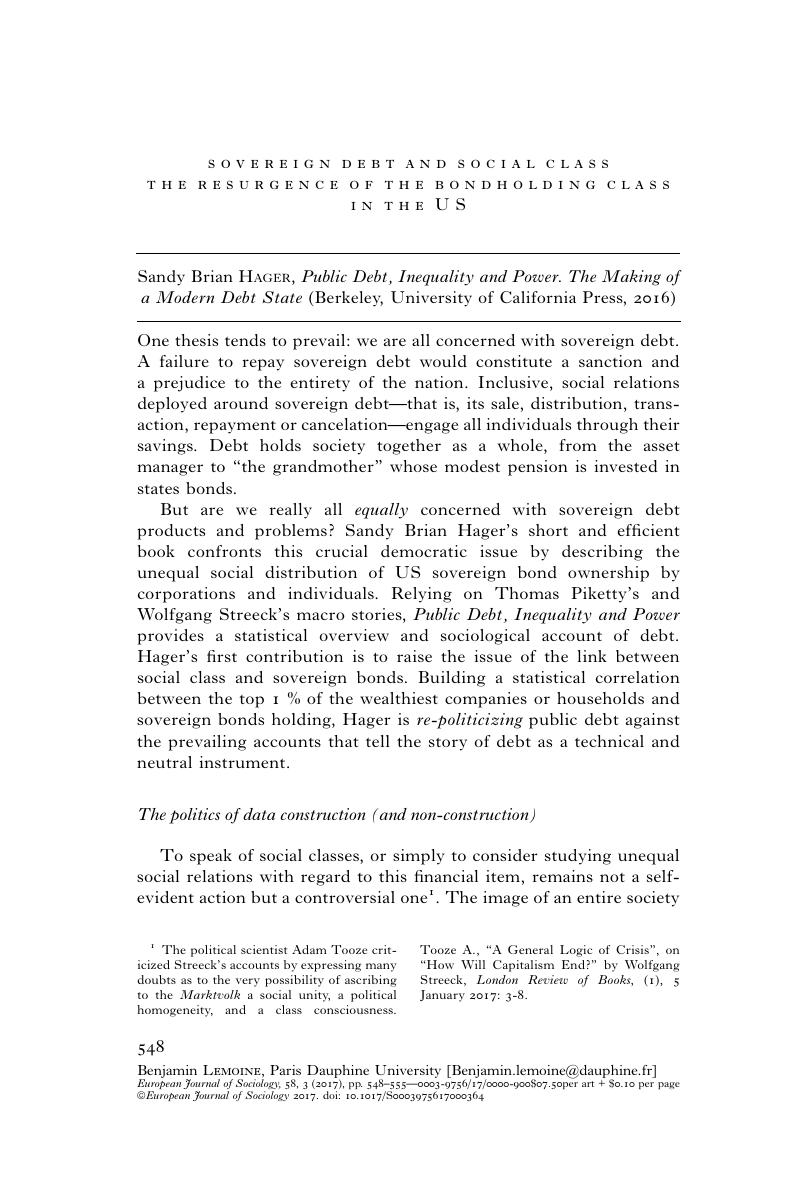No CrossRef data available.
Article contents
Sovereign Debt and Social Class The Resurgence of the Bondholding Class in the US - Sandy Brian Hager, Public Debt, Inequality and Power. The Making of a Modern Debt State (Berkeley, University of California Press, 2016)
Published online by Cambridge University Press: 04 December 2017
Abstract

- Type
- Book Reviews
- Information
- European Journal of Sociology / Archives Européennes de Sociologie , Volume 58 , Issue 3 , December 2017 , pp. 548 - 555
- Copyright
- Copyright © A.E.S. 2017
References
1 The political scientist Adam Tooze criticized Streeck’s accounts by expressing many doubts as to the very possibility of ascribing to the Marktvolk a social unity, a political homogeneity, and a class consciousness. Tooze A., “A General Logic of Crisis”, on “How Will Capitalism End?” by Wolfgang Streeck, London Review of Books, (1), 5 January 2017: 3-8.
2 Francis Cavanaugh, a senior US Treasury official, claimed in the 1990s that public debt was now held by very broad social categories because most households had some of it in the form of savings bonds. Cavanaugh, F.X., 1996, The Truth about the National Debt: Five Myths and One Reality, (Boston, Harvard Business Press). Through trust funds like Social Security, Medicare, and Medicaid, which are widely subscribed, the population and the social state itself are considered as “equally” involved in the US public debt project. Using Congress Budget Office data, Hager however shows that, since 1979, US intra-government debt funds no longer massively represent the interests of ordinary Americans: 46.
3 The dominant view is that market debt is a neutral instrument of financing that would ensure the survival of the public service and the social welfare state at a cheaper cost, thanks to low interest rates. Cf. Lemoine, B., L’ordre de la dette. Enquête sur les infortunes de l’État et la prospérité des marchés (Paris, La Découverte, 2016: 196-225).
4 Le Lann, Y. and B. Lemoine, “Les comptes des générations. Les valeurs du future et la transformation de l’État social”, Actes de la recherche en sciences sociales, “Le conseil de l’État (2)”, 2012, Vol 4, n° 194.
5 Adams, H.C., 1887, Public Debts: An Essay in the Science of Finance, New York, D. Appleton, quoted in Hager: 14.
6 At the end of the book, a very complete appendix examines “how ownership of the public debt has been divided among the various aggregate sectors of the US political economy. Its purpose is to lay the groundwork for the main analysis in the book, which goes beyond broad aggregates to examine the class composition of public debt ownership within these sectors”: 105.
7 Over the past three and a half decades, the 2,500 largest US companies have increased their ownership of public debt by corporations from 65 % in 1977-1981 to 82 % in 2006-2010.
8 Beard C., An Economic Interpretation of the Constitution of the United States (New York, Macmillan, 1921: 150).
9 Other expressions identify the “average American”, such as “John Q. Citizen” and “John Q. Taxpayer”.
10 Théret B., 1991, “Apogée et déclin du rentier de la dette publique dans le ‘grand’ xix e siècle libéral (1815-1935). Éléments pour une réévaluation du développement historique du capitalisme en longue période”, Économies et Sociétés, 14: 87-136.
11 Delalande N., “Protéger le crédit de l’État: Spéculation, confiance et souveraineté dans la France de l’entre-deux-guerres”, Annales, 1, 2016.
12 Streeck W., Du temps acheté, La crise sans cesse ajournée du capitalisme démocratique, Gallimard, Paris, 2014.
13 Ibid.
14 Ibid.
15 Ibid.
16 Lemoine B., 2017, “The Politics of Public Debt Financialization. (Re-)Inventing the Market for French Sovereign Bonds and Shaping the Public Debt Problem (1966-2012)”, in M. Buggeln et al., The Political Economy of Public Finance. Taxation, State Spending and Debt since the 1970s (Cambridge, Cambridge University Press).
17 Piketty T., 2013, Le capital au xxi e siècle (Paris, Seuil : 206).
18 To use the scheme proposed by Pierre Bourdieu.




